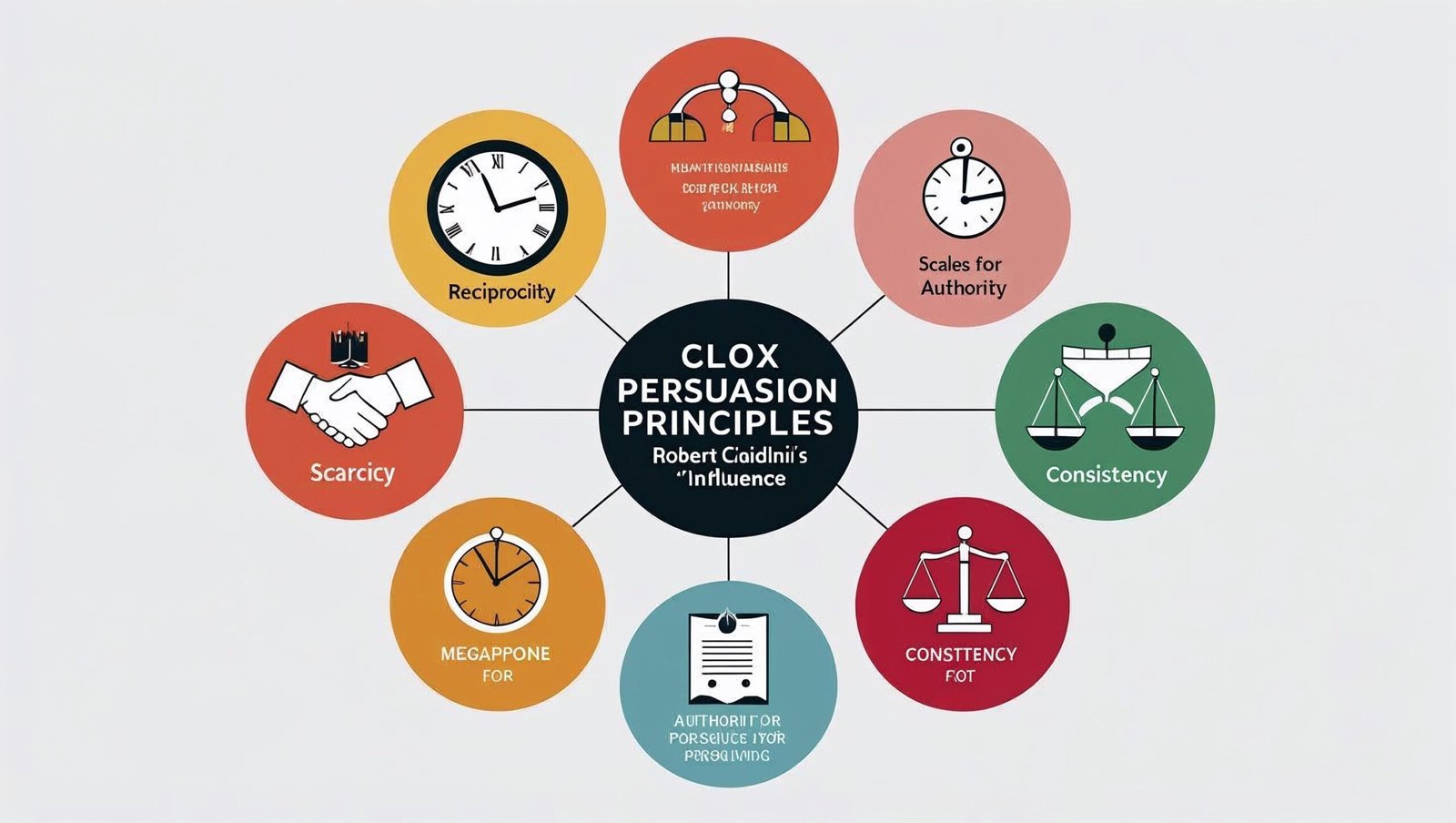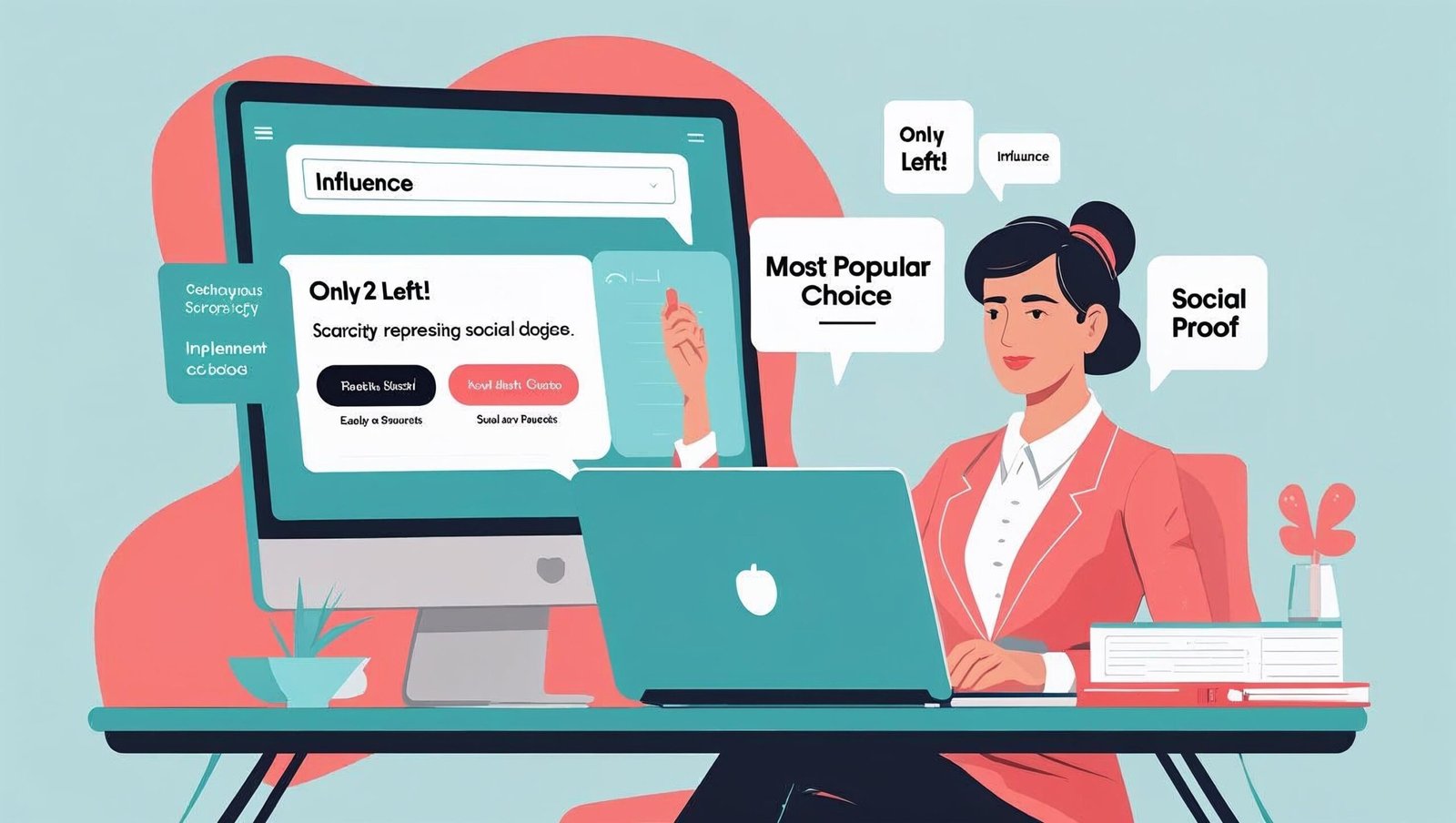Introduction
Among the most celebrated books in the realms of psychology and marketing, Influence by Robert Beno Cialdini stands as a definitive manual on the science of persuasion. Originally published in 1984, this timeless masterpiece delves into the subconscious triggers that guide human decision-making.
Robert Beno Cialdini, a distinguished professor of psychology and marketing, consolidates extensive research into principles that not only shape consumer behavior but also govern daily human interactions. This blog post will examine the eight persuasive principles of influence described by Cialdini, enhanced in his extended editions.
Let us unpack the powerful psychological truths outlined in Influence by Robert Beno Cialdini—truths that can refine your understanding of human behavior and ethical persuasion.

Chapter-by-Chapter Summary of Influence by Robert Beno Cialdini
1. Reciprocation: Give and You Shall Receive
One of the strongest psychological levers explored in Influence by Robert Beno Cialdini is the principle of reciprocation. We are conditioned to repay what we receive—whether it is a favor, a gift, or a kind gesture.
Example: Free samples in stores induce an urge to return the gesture by purchasing.
Application: Offer value first—be it in marketing, negotiations, or networking—and build genuine goodwill.
2. Commitment and Consistency: Stay True to Your Word
Cialdini notes that once individuals commit—especially in writing or public—they are more inclined to act consistently with that commitment.
Example: A small agreement like signing a petition often leads to a larger one, such as donating.
Use in Practice: Begin with small, easy-to-agree actions to establish a behavioral pattern in your audience or client.
3. Social Proof: When in Doubt, Follow Others
In uncertain environments, we look to others for cues on how to behave. This is the core of the social proof principle in Influence by Robert Beno Cialdini.
Example: Product reviews and star ratings serve as social validators in e-commerce.
Implementation: Showcase testimonials, user stats, and peer actions to strengthen influence in your communication.
4. Liking: People Say Yes to Those They Like
The principle of liking is rooted in the fact that people are more likely to comply with requests made by individuals they admire or find relatable.
Factors that enhance liking, as explained in Influence by Robert Beno Cialdini, include physical attractiveness, shared values, familiarity, and genuine praise.
Example: Salespeople who relate to a customer’s background often close more deals.
Tip: Build rapport and express sincere interest to increase your persuasive effectiveness.
5. Authority: Respect for Expertise
Humans tend to obey authority figures, a tendency rooted in societal conditioning. Influence by Robert Beno Cialdini explores how titles, clothing, and credentials bolster one’s persuasive power.
Example: Advertisements that feature doctors endorsing a product lend it immediate credibility.
Tactic: Display qualifications, certifications, or endorsements clearly in your professional communications.
6. Scarcity: The Power of Limited Availability
Scarcity drives desire. As Cialdini elaborates in Influence by Robert Beno Cialdini, people place higher value on things that appear rare or fleeting.
Example: Phrases like “Limited-time offer” or “Only 5 seats left” trigger action.
Effective Use: Employ urgency ethically—whether in sales or content delivery—to prompt quicker decisions.
7. Unity: The Influence of Shared Identity
A later addition to his original six principles, unity highlights how people are more easily influenced by those with whom they share an identity.
Example: National pride, family values, or membership in a particular community can unify people and enhance persuasive messaging.
Practical Insight: Brands and leaders that foster a sense of belonging wield deeper influence.
8. Contrast: The Relativity Principle
Although not included in the original six, the principle of contrast is strongly implied throughout Influence by Robert Beno Cialdini. People evaluate options in comparison to what came before.
Example: A product shown after a much more expensive one appears reasonably priced.
Utility: Frame offers and content in a way that contrasts them against inferior or exaggerated alternatives.

Why Influence by Robert Beno Cialdini Remains Vital in 2025
In a time dominated by information overload, digital distraction, and persuasive noise, Influence by Robert Beno Cialdini offers a lens through which one can make sense of what drives human choices.
From social media strategies to political campaigns, the principles discussed in this book offer enduring relevance. Understanding them not only enhances your ability to influence but also protects you from being manipulated.
Practical Applications for Modern Marketing
1. Reciprocation in Email Campaigns
Offer free resources to build anticipation and trust.
2. Consistency in Customer Journeys
Use opt-ins and surveys to foster progressive commitments.
3. Leverage Social Proof
Highlight real customer experiences in your landing pages.
4. Authority in Branding
Use expert endorsements and academic backing.
5. Scarcity in Promotions
Use limited-time offers with genuine cutoffs.
6. Unity in Messaging
Create “us vs. them” narratives ethically to build brand affinity.
7. Liking via Personalization
Target content that reflects user identity or aspirations.
8. Contrast in Product Displays
Frame your offers against decoy or inflated alternatives.
These applications demonstrate just how actionable Influence by Robert Beno Cialdini is for marketers and communicators in 2025.
Critique: Strengths and Shortcomings
Strengths:
-
Backed by empirical research
-
Engaging writing style
-
Highly applicable across fields
-
Introduces ethical boundaries
Shortcomings:
-
Some anecdotes feel dated
-
Examples skewed toward Western norms
Still, these are minor drawbacks when weighed against the transformative insight Influence by Robert Beno Cialdini delivers.
Who Will Benefit from This Book?
-
Digital Marketers
-
Corporate Leaders
-
Educators and Trainers
-
Sales Professionals
-
Psychology Enthusiasts
If you influence people—or are influenced by them—this book is a necessity.
Memorable Quotes from Influence by Robert Beno Cialdini
-
“The rule says that we should try to repay, in kind, what another person has provided us.”
-
“Once we have made a choice or taken a stand, we will encounter personal and interpersonal pressures to behave consistently.”
-
“People prefer to say yes to individuals they know and like.”
-
“Scarcity and value are tightly connected.”
-
“Authority is most influential when it is legitimate and honest.”
The Science Behind Influence: Why These Principles Work
Before applying the persuasive techniques outlined in Influence by Robert Beno Cialdini, it’s essential to grasp the psychological underpinnings that make these strategies so effective. Each of the eight principles taps into hardwired human instincts—some developed for survival, others cultivated through culture.
For example, reciprocation evolved because mutual cooperation ensured our ancestors’ survival. When someone gives, we are socially compelled to give back, lest we be ostracized. Similarly, social proof functions as a cognitive shortcut—we follow the group when uncertain to avoid danger or effort.
Robert Beno Cialdini’s work is built upon decades of behavioral experiments, surveys, and real-world testing. His blend of empirical science and practical storytelling gives the book its unique and enduring power.

Real-Life Case Studies Using Cialdini’s Principles
1. The Ice Bucket Challenge and Social Proof
In 2014, the ALS Ice Bucket Challenge became a viral movement that raised over $220 million. The campaign’s success was largely due to social proof. People saw others participating and felt compelled to join in, often publicly nominating friends—fueling exponential growth.
2. Amazon’s Use of Scarcity and Social Proof
Amazon masterfully applies multiple principles from Influence by Robert Beno Cialdini. When you see “Only 2 left in stock,” the scarcity trigger nudges urgency. Combine that with user reviews (social proof) and authority (brand credibility), and conversion rates climb sharply.
3. Political Campaigns and Unity
During elections, politicians constantly appeal to shared identity. Whether it’s nationality, religion, or economic class, the unity principle activates a deep-seated desire to align with one’s tribe. It builds allegiance and reduces scrutiny of policies.
These examples prove that Influence by Robert Beno Cialdini isn’t theory alone—it’s living strategy.
Ethical vs. Manipulative Persuasion: Drawing the Line
A central theme in Influence by Robert Beno Cialdini is the ethical use of influence. These principles can be applied responsibly—or manipulated unethically.
| Ethical Influence | Manipulative Persuasion |
|---|---|
| Offering real value in return | Offering fake “bonuses” |
| Demonstrating true scarcity | Faking urgency |
| Citing real authority and credentials | Using actors or fabricated experts |
| Creating genuine unity and connection | Exploiting fear or polarization |
Cialdini’s call is clear: Use these tools to create win-win outcomes, not to deceive.
Bonus Quotes to Reflect On
-
“A well-known principle of human behavior says that when we ask someone to do us a favor we will be more successful if we provide a reason.”
-
“The truly gifted persuaders are also the ones who know the ethical boundaries and respect them.”
-
“Those who know how to use the principles of influence ethically become forces for good in both commerce and culture.”
These bonus quotes expand on the essence of the book and affirm the integrity Cialdini advocates.
Further Reading Recommendations
If Influence by Robert Beno Cialdini resonated with you, consider exploring the following:
-
Pre-Suasion by Robert Beno Cialdini: Focuses on what happens before the message.
-
Thinking, Fast and Slow by Daniel Kahneman: Explores cognitive biases in decision-making.
-
Made to Stick by Chip and Dan Heath: Examines what makes ideas “sticky” or memorable.
-
Nudge by Richard Thaler and Cass Sunstein: How to structure choices for better outcomes.
These books expand on the same psychological and behavioral themes.

The Psychology of Scarcity: Why “Less” Equals “More”
One of the most powerful concepts in Influence by Robert Beno Cialdini is scarcity. The less available something is, the more valuable it seems. But why?
Psychologists suggest this is rooted in reactance theory—we value our freedom of choice. When something becomes scarce, it feels like our freedom to choose is being threatened, which causes us to desire it more. Scarcity doesn’t always refer to material goods. Time-sensitive decisions, limited seating in webinars, or early-bird bonuses in online courses—all evoke urgency that bypasses logic.
Cialdini explains that this is often manipulated in marketing, but it can also be used ethically. For instance, a consultant with a full calendar signals value. A limited-release book or limited-edition art piece can enhance perceived prestige. The key is authenticity—manufactured scarcity eventually erodes trust.
If you’re launching a product or service, use scarcity wisely. Create genuine urgency—not false alarms.
Applying Influence to Self-Development
While most readers of Influence by Robert Beno Cialdini focus on external persuasion, there’s a powerful internal application: using these principles to influence yourself.
-
Commitment & Consistency: Write down your goals publicly or announce them on social media. This simple act creates internal pressure to stay aligned with your stated identity.
-
Authority: Follow and learn from credible mentors. Their expertise can shortcut years of trial and error.
-
Social Proof: Surround yourself with high-performing individuals. Their habits and standards will gradually raise your own.
-
Scarcity: Limit your distractions. Make your attention a scarce resource and direct it toward your growth.
When applied inwardly, the six principles (plus unity) can be life-transforming. Influence doesn’t just shape others—it can sculpt your destiny.
Influence in Education and Parenting: Teaching Through Persuasion
One often overlooked domain where Influence by Robert Beno Cialdini proves incredibly useful is in the realm of education and parenting. Teachers and parents regularly need to gain cooperation, instill values, and guide behavior—and influence plays a silent but central role.
For example, the commitment and consistency principle can help students stay accountable. When a child writes down a personal learning goal or signs a behavior pledge, they are more likely to follow through. Similarly, the authority principle reinforces learning when the instructor is perceived as both knowledgeable and trustworthy.
In parenting, reciprocity works remarkably well—modeling kindness and respect often invites children to mirror the same. Rather than control or command, influence fosters an environment of voluntary cooperation.
By incorporating Robert Beno Cialdini’s principles in these foundational settings, we cultivate not just obedience, but critical thinking, emotional intelligence, and lifelong values—proving once again how universally applicable this work truly is.
Understanding and applying these principles empowers us not just to persuade others, but to navigate a world full of hidden influences. Awareness turns manipulation into strategy and confusion into clarity. As Robert Beno Cialdini reminds us, influence is everywhere—and knowing how it works is a true advantage.
Final Reflections
The ideas laid out in Influence by Robert Beno Cialdini are not passing trends. They are timeless tools that explain how humans connect, convince, and cooperate. Whether you’re a marketer, educator, leader, or lifelong learner, mastering these tools will elevate every interaction you have.
To grow in your knowledge, refine your ethical persuasion, and uncover more such insights:
🔗 Visit shubhanshuinsights.com

FAQs: Influence by Robert Beno Cialdini
Q1: What is Influence by Robert Beno Cialdini about?
It explores eight psychological principles that explain how and why people say “yes” and how to use those principles ethically.
Q2: Why is the book still relevant in 2025?
Because the psychological triggers it identifies are timeless and universal, applicable across digital, personal, and commercial contexts.
Q3: Can the principles be used unethically?
Yes, which is why the book also emphasizes the responsibility to apply them morally and transparently.
Q4: Where can I buy the book?
It’s available on Amazon, Flipkart, and most major bookstores both online and offline.
Q5: What principle is most powerful?
While all are impactful, most marketers find scarcity and social proof to be particularly effective in driving conversions.
Q6: What is the difference between influence and manipulation?
Influence is about ethically guiding someone to a beneficial decision; manipulation involves coercion or deception to serve only the persuader’s interests.
Q7: Is Influence by Robert Beno Cialdini useful for introverts?
Absolutely. The principles don’t require loud or aggressive behavior—they work silently in emails, copywriting, one-on-one interactions, and even UX design.
Q8: How long does it take to see results from applying these principles?
Depending on the context—marketing, negotiation, social situations—results can appear instantly (like a CTA click) or build over time through trust.
Q9: Are these principles applicable in different cultures?
Yes, but with adaptation. For instance, collectivist societies may respond more to unity and social proof, while individualistic ones may lean toward authority or scarcity.
Q10: What’s the best way to master these concepts?
Read the book deeply, observe real-life applications, and test them ethically in low-risk scenarios like emails, content writing, or conversations.
Conclusion
The principles in Influence by Robert Beno Cialdini are more than clever tricks; they are rooted in timeless truths about how people think and act. Whether you’re an entrepreneur, leader, creator, or simply someone who interacts with others daily, this book equips you with invaluable psychological tools.
As we’ve explored in this now expanded review, understanding these principles allows you to communicate more effectively, protect yourself from manipulation, and leave a positive mark in your personal and professional life.
For more insightful book reviews, deep dives into behavior science, and transformative knowledge, visit:
Engaging Reader Comments
-
“The explanation of Unity struck a chord with me. Relevant in today’s divided world.”
-
“I always wondered why ‘only 3 left’ makes me act fast. Now I know!”
-
“Brilliant breakdown of a legendary book. Bookmarked and shared!”
-
“This summary is more actionable than most self-help books. Subscribed!”
-
“Influence has been on my reading list—this just convinced me to read it next.”